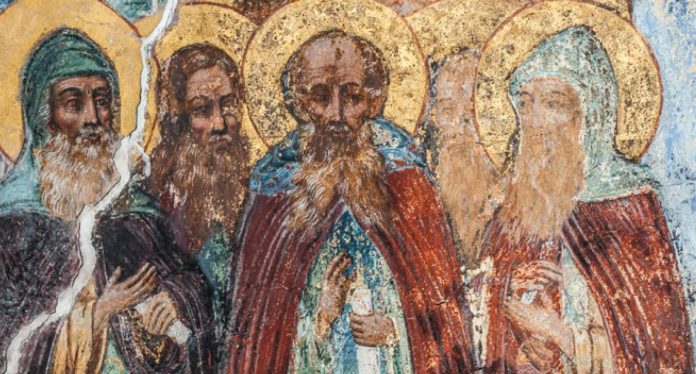
Fun with the saints and holy souls
BY LISA MLADINICH
We know that God is infinite and unchanging, yet his children come to him through myriad pathways. The Blessed Mother and all of our canonized saints were stunningly individual, even while submitting their distinctive personalities and desires to the Church they loved so selflessly. We can learn so much from them— and then share that beauty and wisdom with our students.
In their rich diversity they are refractions of the one pure light of the Holy Spirit (CCC, 2684).
Through devotion to the saints, we open ourselves to acquire their virtues and be strengthened in our daily lives.
I enjoy researching elementary students’ names in order to tell them about their patrons as they listen wide-eyed. A simple party can be planned—the children can dress up as their favorite saint and take turns giving hints to the class until someone guesses correctly. Sending them home with prayer cards for their patrons is another way to inspire what can become a lifelong walk with a heavenly friend.
A confirmation catechist I once met had his teens research their chosen patron and then make a simple coat of arms for their saint. Each student was given a sheet of white card stock with an image of a shield divided into four quadrants traced onto it. After cutting out the shield, they cut a one-inch by seven-inch piece of stock to glue or staple to the center of the blank side, forming a handgrip. On the front, in the four quadrants of the shield, they drew or colored symbols for their saints.
On the St. Joseph shield, for instance, the symbols might be a carpenter’s tool, a white lily for purity, an angel, and a silhouette of a Jewish temple. For Mary, it might be an angel, a rosary, the star of Bethlehem, and a lily.
On the reverse, above the handgrip, each student was asked to write at least five fun facts about their saint and then challenge their classmates to guess his/her identity by offering one clue at a time. While displaying the symbols for St. Joseph on the front, for example, a student might give the following hints: 1) received angelic messages in dreams; 2) a powerful saint known by the title “Terror of Demons”; 3) born of the line of King David; 4) a carpenter; 5) the protector of the Holy Family.
Children and teens also enjoy hearing or reading about the lives of the saints, especially when their stories are told with conviction and love. Satisfying their hunger for drama and heroism, one catechist loves to engage her confirmandi with the lives of her favorite Catholic martyrs: Maximilian Kolbe, Maria Goretti, Tarcisius, and others. Since she has been praying to them for years and studying their lives, they are old friends to her. Her students are spellbound as she wraps them in the stories of these amazing witnesses to faith.
Many children find the tradition of praying for the holy souls in purgatory both fascinating and compelling (see CCC, 1030-1032). It can be a great gift to their spiritual lives. Few young people are strangers to the loss of a relative, friend, or neighbor, and discovering that they can help speed a loved one’s progress to heaven is an engaging revelation.
But there’s more. The Catechism states, “Our prayer for them is capable not only of helping them, but also of making their intercession for us effective” (CCC, 958). The prayers of the holy souls are powerful, and once they get to heaven, those we’ve befriended and assisted will not cease to pray for our souls until we enter heaven. Students can participate in assembling spiritual bouquets (promised prayers and good works) for the holy souls, with their offerings written on a large card displayed on your prayer table, during the month of November.
The festive tradition of begging for soul cakes is both instructive and enjoyable. In medieval times, on All Hallows Eve Catholic children in England would knock on their neighbors’ doors, begging for treats. In exchange, they promised to pray for the souls of any deceased family members. Out of this tradition arose what we now know as Halloween, and children love discovering that its roots are firmly within the traditions of their beloved Church.
By bringing the saints and Holy Souls to life in the minds of children, we teach them that they are part of a remarkable and inspiring family: the communion of saints! (See CCC, 946-962).
***
HELPFUL RESOURCES:
- For All Saints Day activities, crafts, and costumes: CatholicIcing.com/category/saints/.
- For litanies, including the saints: CatholicDoors.com/prayers/litanies.htm.
- For novena prayers and timely reminders: PrayMoreNovenas.com.
- For celebrations, search for All Saints Day and All Souls Day at CatholicCulture.org.
Lisa Mladinich is the founder of AmazingCatechists.com and the author of Heads Bowed: Prayers for Catholic School Days (Liguori Publications).
This article originally appeared in Catechist magazine, Nov/Dec 2016.
Image credit: Shutter Stock 371012348




